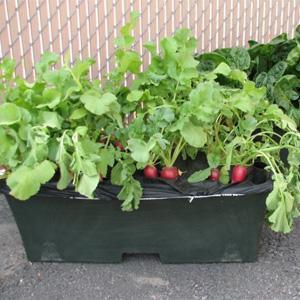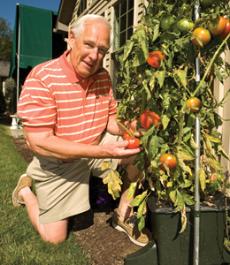
CHRISTOPHER CRUISE: This is SCIENCE IN THE NEWS in VOA Special English. Today, we tell about an American farmer and an unusual device he developed. For nearly 20 years, people around the world have been buying his invention.
(MUSIC)
JIM TEDDER: Blake Whisenant and his family are farmers. They live in the American state of Florida. For nearly 100 years, Mr. Whisenant's family has grown fruits and vegetables, and sold them to businesses around the world. The warm weather in central Florida is good for growing crops, especially tomatoes. That is what he grows the most of on his 800 hectares of land.
In 1992, Mr. Whisenant had some bad luck.
(SOUND)
It began to rain. And it rained. And it rained some more. Nearly 50 centimeters of rain destroyed the tomato crop that year.
JIM TEDDER: Blake Whisenant was not a happy farmer.
(MUSIC)
BLAKE WHISENANT: "I just thought there's got to be a better way!"
So, he began looking to find a way to make sure this never happened again. He wanted to develop a system that would provide water to the plants from below. He thought some kind of cover would keep rain away and the soil warm. He wanted the plants to be grown in a box that would take up little space. He became obsessed with the idea and thought about it day and night.
BLAKE WHISENANT: "And I told my wife, before I die I wanted to see if I could build me a box above the ground that I could grow tomatoes in."
And after years of work, he knew what to do. He found a company in Pennsylvania that agreed to make the box. It would be made of thick plastic, and would be about one meter long and half a meter deep. Inside the box would be a plastic tube to pour the water in, and a plastic screen with many holes in it.
Something like peat moss, but not soil, would be placed in the box on top of the screen, which would hold it above the water in the bottom of the box. A thin plastic cover would fit over the top of the box to keep out rain and harmful insects. Blake called it the Earthbox.
(MUSIC)
JIM TEDDER: Frank DiPaolo is the general manager of the Earthbox Company in Scranton, Pennsylvania. He says that growing vegetables this way...container gardening some call it...makes it easy for Blake Whisenant and other farmers to quickly solve common growing problems.
FRANK DiPAOLO: "When he saw any sort of disease or problems with the plants in the field, one human being could basically go and grab the box and just pull that problem right out of the field before it spread to the other plants."
JIM TEDDER: Frank DiPaolo says normal dirt or soil will not work in this kind of container gardening. Instead, potting mix is used. This is mostly peat moss with a few things added to help air get to the roots of the plants.
FRANK DiPAOLO: "One of its responsibilities is to wick the water up to the plants. When you put a small seedling in, the roots are not deep enough to go into that water reservoir, so we need to bring the water up to the plant."
JIM TEDDER: The box holds about 11 liters of water. There is a small hole in the side to drain out extra moisture and keep from drowning the plants. Since the potting mix soaks up the water, you have to pour more water down the tube every day or so. This kind of container gardening uses much less water than is needed when growing plants in the ground. And it is made so you can never give too much or too little water to the plants.
The plants in the box also need two other things...a small amount of fertilizer and dolomite, a powder-like substance made from limestone. The fertilizer feeds the plants and helps them grow. The dolomite helps to reduce acid in the potting mix. Many farmers say dolomite is the secret to growing good tasting tomatoes.
Dolomite is also a low-cost way to supply calcium to young tomato plants. This helps to protect the plants from a disease known as "blossom end rot."

FRANK DiPAOLO: "That's where your tomato plant will start setting fruit ...and they look beautiful and you come back a couple of days later and they've grown to a pretty nice size...and the bottom of the tomato is all black. And they call that blossom end rot."
JIM TEDDER: Before the plants are put in the Earthbox, there is one more thing that must be done. A thin plastic cover is stretched over the top of the box. If storms should bring large amounts of rain, the cover protects the potting mix, fertilizer, and dolomite inside the box. This cover also keeps weeds and harmful insects out of the box. But there is one other reason that the container must be covered. It is important that the potting mix be kept warm, but not too hot. Frank DiPaolo says you should use either a white or a black cover.
FRANK DiPAOLO: "The covers that we ship with the box are black on one side and white on the other. If you live where we live in northeastern Pennsylvania and you want to drive as much heat as you can into the container, we plant the plants with the black side up. Say, if you were in Florida where Blake lives, in the summer he'll plant with the white side up. You get about a 15 degree Fahrenheit change in the soil temperature just by using the white side versus the black side."
JIM TEDDER: There also has been some research done using other colors for the box covers. One study found that a red cover produces better results for vegetables like tomatoes and red peppers.
Frank DiPaolo says that, if you prepare the box correctly, nature will do the rest.
FRANK DiPAOLO: "The plants know what they need from a nutritional and a water sense. So if you put the materials within reach of the plant, the plant will take what it needs when it needs it."
JIM TEDDER: So after preparing the box, how many tomato plants do you use? The answer is ...only two! And why is that?
FRANK DiPAOLO: "The reason is that those plants are going to get so big that if you were to put three or four or six plants in, they are just going to be crowding each other out, and each plant is going to underperform."
JIM TEDDER: Putting the plants in the box is easy. Blake Whisenant uses a sharp knife to cut a small round hole in the cover. He then uses his hand to take out a small amount of potting mix. He sets the plant into the hole, presses the roots down a bit, and then puts back the handful of potting mix.
Many people who have used Earthboxes say it is possible to get over 22 kilograms of tomatoes, from just two plants.
(MUSIC)
JIM TEDDER: Growing crops in containers is good for the environment. In addition to using less water, little fertilizer is needed, and it all stays in the box. There is no way the chemicals can run off into nearby waterways. The same potting mix can be used for five or six years. In countries where potting mix is not available or too costly, growers can use coconut coir instead. This comes from the outside shell of the coconut and it is low in cost.
Coconut coir is also a renewable resource. Each new coconut that grows will provide some coir. The peat moss that is used in many potting mixes, however, can take thousands of years to grow. Gardeners can use up peat moss much faster than it can be replaced by nature.
Since the Earthbox went on sale in 1994, many people around the world have used them. Other people have made their own vegetable growing boxes. Some use two large plastic containers to make what is known as a "Global Bucket." One bucket has holes in the bottom and sits inside the other bucket. Potting mix or coir goes into the top bucket, and water goes through a tube into the bottom bucket. A plastic trash bag is then used to cover the top container.
Many kinds of fruits and vegetables can be grown in containers like these. Some people think this kind of gardening will be important for people in poor countries where hunger is a problem. A lot of food can be grown in a small space for a small amount of money.
(MUSIC)
JIM TEDDER: The people who make Earthboxes are interested in educating young people. They have developed a program aimed at teaching science and agriculture to students from their prekindergarten years through high school. Using an Earthbox in the classroom, the youngest child learns about seeds, the parts of plants, how gravity affects plants, and the uses of sunflowers.
When children first enter elementary school, they learn about water, soil, light, and nutrition. In middle school, they do experiments and collect information. In high school, the students learn how to use mathematics and graphs to better understand what happens when plants grow. The learning program includes written materials for the teachers and students. And it uses an Earthbox in the classroom as a small laboratory for experiments.
Molly Philbin is the Education and Community Garden director for the Earthbox Company.
MOLLY PHILBIN: "Kids really get engaged in science in the garden where it's a kind of fun activity where they're collecting data and seeing how different temperatures will change the amount of water that's needed by a crop, so the science concepts come easily."
JIM TEDDER: Ms. Philbin also says that growing food locally in a container helps lower pollution from burning fossil fuels like oil. Often food travels thousands of kilometers from the farm before it reaches the table at home. A lot of fuel is needed just to deliver the food. Farmers who use growing boxes do not have to plow the land before they plant crops. That saves on the cost of fuel and on the pollution from farm machinery.
The man who started it all, Blake Whisenant, still lives near his farm in Florida. Health problems and age -- he is over 80 -- now keep him from working in the fields. But he still goes to the Earthbox store nearly every day and enjoys teaching classes about agriculture to visitors. He says he likes the idea of passing along his knowledge to the next generation. Helping to educate the children, Blake says, has been a blessing.
(MUSIC)
CHRISTOPHER CRUISE: This SCIENCE IN THE NEWS was written, read and produced by Jim Tedder. Join us again next week for more news about science in Special English on the Voice of America. I'm Christopher Cruise.
dolomite: a translucent mineral consisting of a carbonate of calcium and magnesium 白云石;石灰岩
Study links climate change to changes in crop yields
In Africa, the greening of the Sahel
Bags help farmers protect harvests from air and insects
Fish farms may soon supply more than half the world's catch
(来源:VOA 编辑:崔旭燕)
